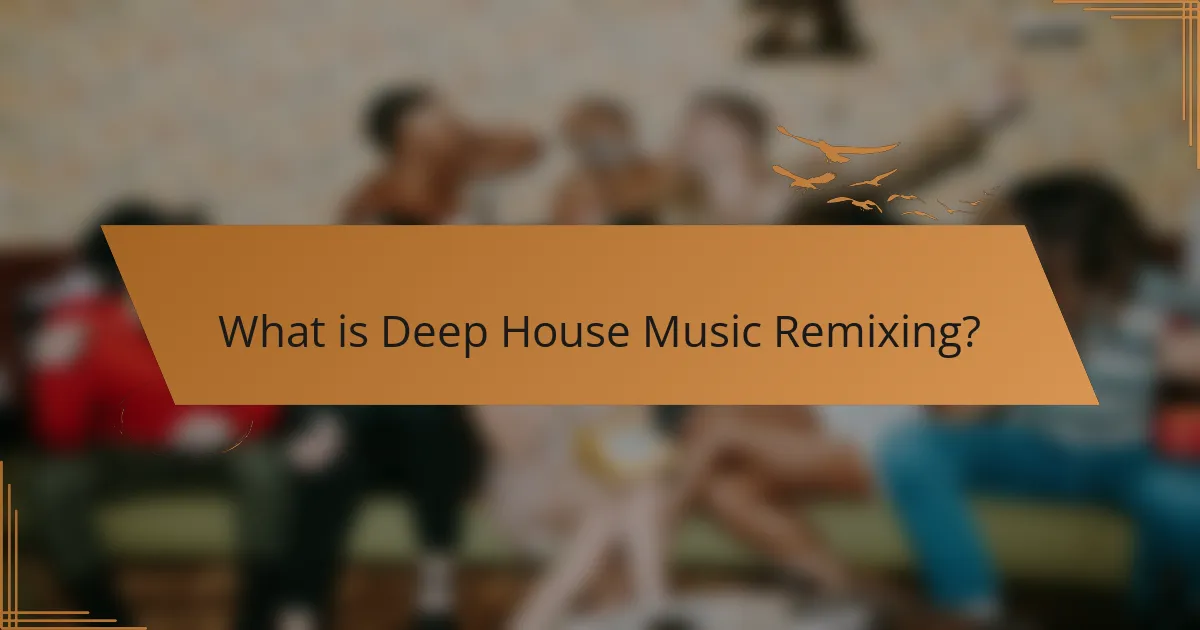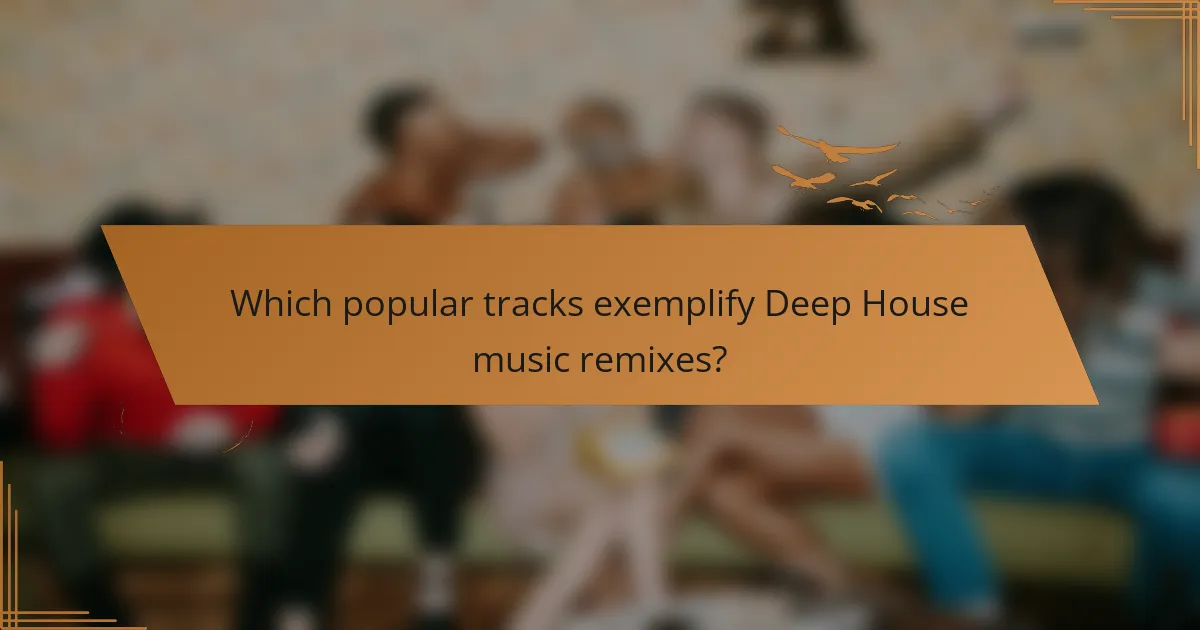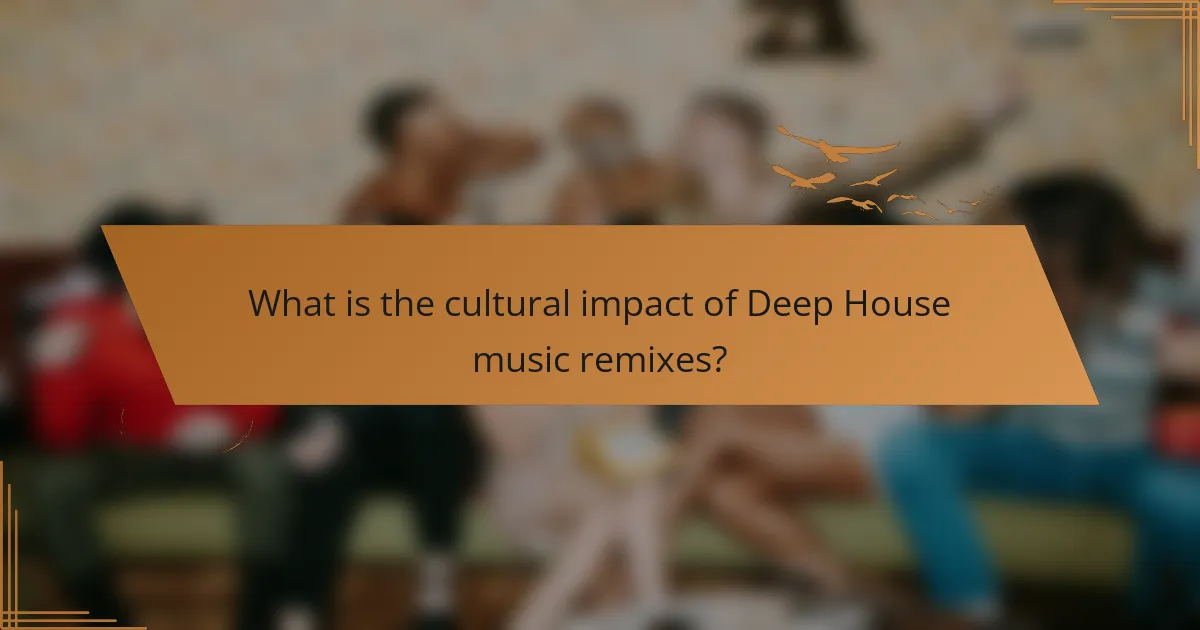Deep House Music Remixes involve reinterpreting existing deep house tracks by altering elements such as tempo, instrumentation, and structure. This process enhances the original songs, often introducing new beats or vocal arrangements, while maintaining the essence of the original. Popular tracks like ‘Can’t Get Enough’ by Soulsearcher and ‘Look Right Through’ by Marc Kinchen exemplify the genre’s appeal, showcasing smooth basslines and soulful vocals. The cultural impact of Deep House remixes extends to the evolution of electronic dance music (EDM), promoting inclusivity and community through dance and social gatherings. Additionally, the accessibility of digital platforms has facilitated cross-cultural collaborations, enriching the music scene and enhancing emotional connections for listeners.

What is Deep House Music Remixing?
Deep House Music Remixing is the process of reinterpreting existing deep house tracks. This involves altering elements such as tempo, instrumentation, and structure. Remixing can introduce new beats or vocal arrangements. It often aims to create a fresh take on the original song. The practice is common in the electronic music scene. Many well-known artists engage in remixing to reach broader audiences. Remixing can enhance the track’s danceability or emotional impact. Successful remixes often maintain the essence of the original while adding unique flair.
How did Deep House music evolve into a remix culture?
Deep House music evolved into a remix culture through its emphasis on collaboration and reinterpretation. The genre emerged in the 1980s, blending elements of house music with jazz, soul, and funk. This fusion encouraged producers to experiment with existing tracks. As technology advanced, tools for remixing became more accessible. Digital audio workstations allowed artists to manipulate sounds easily. The rise of platforms like SoundCloud facilitated sharing and discovery of remixes. Additionally, the culture of DJing promoted reimagining tracks for live sets. This dynamic environment created a rich tapestry of remixed Deep House tracks, solidifying its place in electronic music culture.
What are the defining characteristics of Deep House music?
Deep House music is characterized by its smooth, soulful sound and emphasis on melody. It typically features a tempo range of 120 to 125 beats per minute. The genre often incorporates deep basslines and atmospheric synths. Vocals in Deep House are usually soft and melodic, often with a soulful or jazzy influence. The use of complex chord progressions is common, contributing to its rich harmonic texture. Deep House also emphasizes a laid-back, relaxed vibe, making it suitable for both dance floors and casual listening. The genre emerged in the 1980s, influenced by Chicago house and jazz-funk. Its defining elements continue to evolve while maintaining a strong connection to its roots.
How do remixes differ from original Deep House tracks?
Remixes differ from original Deep House tracks primarily in their structure and production techniques. A remix typically reinterprets an existing track by altering elements such as tempo, instrumentation, and arrangement. This process often introduces new beats or vocal samples that were not present in the original.
Additionally, remixes may emphasize different aspects of the original track, such as basslines or melodies. This can create a fresh listening experience while still retaining recognizable elements of the original.
The production of a remix often involves collaboration with various artists, which can lead to diverse stylistic influences. This collaborative nature can result in unique sounds that appeal to different audiences.
In contrast, original Deep House tracks are created from scratch, showcasing the artist’s unique style and vision. They establish the foundational elements that remixes build upon.
What techniques are commonly used in Deep House music remixes?
Common techniques used in Deep House music remixes include sampling, layering, and filtering. Sampling involves taking snippets from existing tracks to create new compositions. Layering adds multiple sounds or instruments to enrich the mix. Filtering modifies audio frequencies to enhance specific elements.
Additionally, effects like reverb and delay create depth and space in the sound. Beat matching ensures smooth transitions between tracks. These techniques contribute to the signature sound of Deep House, which is characterized by smooth basslines and atmospheric elements.
What role do sampling and looping play in remixing?
Sampling and looping are essential techniques in remixing. Sampling involves taking a portion of a sound recording and reusing it in a different song or piece of music. This technique allows remixers to incorporate recognizable elements from original tracks, creating a sense of nostalgia and connection. Looping, on the other hand, refers to repeating a segment of music continuously. This creates rhythmic and melodic foundations that can enhance the overall structure of a remix. Both techniques enable artists to manipulate and transform existing sounds, providing new contexts and interpretations. Historical examples include the use of samples from disco tracks in early house music, which laid the groundwork for deep house remixes.
How does tempo and rhythm influence a Deep House remix?
Tempo and rhythm significantly shape a Deep House remix. The typical tempo for Deep House ranges from 120 to 125 BPM. This tempo creates a laid-back yet danceable groove. Rhythm contributes to the overall feel and energy of the track. Syncopated beats and off-beat hi-hats are common in Deep House. These elements enhance the track’s complexity and depth. Additionally, variations in rhythm can evoke different emotional responses. For instance, a steady rhythm promotes relaxation, while a more dynamic rhythm can energize the listener. Thus, tempo and rhythm are crucial in defining the character of a Deep House remix.
What software and tools are essential for creating remixes?
Essential software and tools for creating remixes include Digital Audio Workstations (DAWs) like Ableton Live, FL Studio, and Logic Pro. These DAWs provide comprehensive features for audio editing, sequencing, and mixing. Additionally, plugins such as Serum, Massive, and Omnisphere enhance sound design capabilities. Sample libraries like Splice and Loopmasters offer a wide range of sounds for remixing. Hardware tools like MIDI controllers and audio interfaces improve workflow and sound quality. Each of these tools is widely used in the music industry, proving their effectiveness in remix production.

Which popular tracks exemplify Deep House music remixes?
“Deep House music remixes are exemplified by tracks such as ‘Can’t Get Enough’ by Soulsearcher and ‘Look Right Through’ by Marc Kinchen. These tracks feature characteristic elements of Deep House, including smooth basslines and soulful vocals. ‘Can’t Get Enough’ became a staple in clubs, showcasing the genre’s appeal. ‘Look Right Through’ achieved significant chart success, further solidifying the popularity of Deep House remixes. Both tracks highlight the genre’s blend of house rhythms with deep, emotive melodies.”
What are some iconic Deep House remixes that shaped the genre?
“Deep House remixes that shaped the genre include ‘Can’t Get Enough’ (Soulsearcher) remixed by Armand Van Helden. This remix is iconic for its infectious groove and widespread popularity in the late 1990s. Another significant remix is ‘Finally’ (Kings of Tomorrow) by Sandy Rivera, which became a staple in deep house playlists. ‘Deep End’ by John Summit, remixed by several artists, showcases a modern take on the genre. The remix of ‘I Feel for You’ (Bob Sinclar) by the artist himself influenced the sound of deep house in the 2000s. Each of these remixes contributed to defining the deep house sound, blending elements of soul, funk, and electronic music.”
How have remixes of classic tracks contributed to their longevity?
Remixes of classic tracks have significantly contributed to their longevity by revitalizing interest and introducing them to new audiences. By updating the sound and production techniques, remixes make these tracks relevant in contemporary music scenes. For instance, a remix can incorporate modern beats or styles, appealing to current listener preferences. This process often leads to increased streaming and radio play, extending the track’s life cycle. Additionally, remixes can spark renewed discussions and nostalgia among fans of the original version. Notably, classic tracks like “I Feel for You” by Prince have seen numerous remixes that keep them in the public’s ear. Overall, remixes serve as a bridge between past and present, ensuring classic tracks remain a part of the musical conversation.
Which contemporary artists are known for their Deep House remixes?
Contemporary artists known for their Deep House remixes include Disclosure, Duke Dumont, and Gorgon City. Disclosure gained prominence with their remix of “Get Lucky” by Daft Punk. Duke Dumont is recognized for his hit “Need U (100%)” remix. Gorgon City has made significant contributions with tracks like “Imagination.” These artists have shaped the Deep House genre through their innovative remixes. Their works often blend soulful vocals with deep basslines, creating a unique sound.
What impact do remixes have on the popularity of Deep House tracks?
Remixes significantly enhance the popularity of Deep House tracks. They introduce tracks to broader audiences by providing fresh interpretations. Remixes often feature popular artists, attracting their fan bases. This collaboration can lead to increased streaming and chart performance. Additionally, remixes can revitalize older tracks, extending their life cycle in the music market. According to a study by Beatport, remixed tracks often see a 30% increase in play counts. This demonstrates the effectiveness of remixes in boosting visibility and engagement.
How do remixes influence the mainstream acceptance of Deep House music?
Remixes significantly influence the mainstream acceptance of Deep House music by making it more accessible to wider audiences. They often incorporate popular elements from other genres, increasing appeal. This cross-genre blending attracts listeners who may not typically engage with Deep House. Additionally, remixes can feature well-known artists, enhancing visibility. The presence of familiar vocals or hooks can draw in new fans. A notable example is the remix of “Can’t Get Enough” by Soulsearcher, which brought Deep House to mainstream radio. This exposure helps solidify Deep House’s place within popular music trends. Overall, remixes act as a bridge, connecting Deep House to the broader music landscape.
What role do remixes play in music festivals and events?
Remixes play a significant role in music festivals and events by enhancing audience engagement. They reinterpret original tracks, creating fresh experiences for listeners. This revitalization often leads to increased energy on the dance floor. Remixes can also bridge different genres, attracting diverse crowds. They allow DJs to showcase their creativity and unique styles. According to a study by the International Journal of Music Business Research, remixes can boost track popularity by over 30%. This impact is evident at festivals where remixed tracks often become highlights of performances. Overall, remixes contribute to the dynamic atmosphere of music festivals and events.

What is the cultural impact of Deep House music remixes?
Deep House music remixes significantly influence contemporary culture. They blend various genres, creating a unique sound that resonates with diverse audiences. This genre promotes inclusivity and community through its emphasis on dance and social gatherings. Remixes often reinterpret original tracks, allowing for new artistic expressions and cultural dialogues.
Deep House remixes have played a role in the evolution of electronic dance music (EDM). They have contributed to the global rise of club culture since the 1980s. Events like festivals and underground parties often feature these remixes, fostering a sense of belonging among attendees.
The accessibility of digital platforms has further amplified the reach of Deep House remixes. Artists can share their work widely, leading to cross-cultural collaborations. This exchange enriches the music scene and encourages creative innovation.
Research indicates that remixes can enhance emotional connections to music, making them impactful on listeners. The cultural significance of Deep House remixes continues to grow, reflecting broader societal trends and values.
How do Deep House remixes reflect social and cultural trends?
Deep House remixes reflect social and cultural trends by incorporating diverse musical elements and styles. These remixes often blend genres, showcasing cultural fusion. For example, they may integrate jazz, funk, or soul influences, reflecting the historical roots of house music. Additionally, the themes in Deep House lyrics often address social issues, love, and community, resonating with listeners’ experiences. The rise of online platforms has democratized music production, allowing voices from various backgrounds to be heard. This inclusivity mirrors contemporary social movements advocating for representation. Furthermore, the popularity of Deep House in urban nightlife scenes highlights its role in shaping cultural identities and social interactions. Overall, Deep House remixes serve as a soundtrack to evolving societal narratives.
What communities are most influenced by Deep House music culture?
Deep House music culture significantly influences urban communities, particularly in cities like Chicago, Detroit, and Berlin. These cities are known for their rich musical history and vibrant nightlife. The Chicago house scene birthed Deep House in the 1980s, establishing a strong cultural foundation. Detroit’s techno scene also intersects with Deep House, creating a blend of influences. Berlin has become a global hub for electronic music, attracting diverse audiences. Additionally, [censured] communities often embrace Deep House for its inclusive nature. The genre’s emphasis on soulful melodies resonates with various cultural expressions, fostering a sense of belonging.
How do remixes contribute to the globalization of music?
Remixes contribute to the globalization of music by blending diverse cultural sounds and styles. They allow artists to reinterpret existing songs, incorporating elements from various genres. This fusion creates a unique listening experience that appeals to a global audience. Remixes often spread through digital platforms, reaching listeners worldwide. The accessibility of these platforms facilitates the exchange of musical ideas across borders. For example, deep house remixes often incorporate elements from different musical traditions, enhancing their appeal. This cross-pollination of styles fosters cultural exchange and collaboration among artists globally. Consequently, remixes play a crucial role in expanding the reach of music beyond local markets.
What challenges do remix artists face in the Deep House genre?
Remix artists in the Deep House genre face several challenges. One significant challenge is copyright issues. Many remix artists must navigate complex licensing laws when using original tracks. This can lead to legal disputes or the inability to release remixes. Another challenge is maintaining originality. Artists must create unique interpretations while respecting the source material. Additionally, competition is fierce in the Deep House scene. Many artists are vying for attention, making it difficult to stand out.
Moreover, remix artists often encounter technical limitations. High-quality production requires advanced skills and equipment. Budget constraints can hinder access to professional tools. Lastly, audience expectations pose a challenge. Fans may have strong preferences for certain styles or artists, which can limit creative freedom. These challenges collectively impact the success and recognition of remix artists in the Deep House genre.
How do copyright laws affect the remixing process?
Copyright laws significantly impact the remixing process by regulating the use of original works. These laws require remixers to obtain permission from the original creators before using their material. Failure to do so can result in legal consequences, including lawsuits and financial penalties. Additionally, copyright laws protect the rights of original artists, ensuring they receive credit and compensation. In many jurisdictions, fair use provisions may allow limited remixing without permission, but this is often a gray area. Therefore, remixers must navigate these laws carefully to avoid infringement. Understanding copyright is essential for anyone involved in creating remixes in the deep house music genre.
What are common misconceptions about Deep House music remixes?
Common misconceptions about Deep House music remixes include the belief that they lack originality. Many assume remixes are merely repetitive copies of the original tracks. In reality, remixes often showcase unique artistic interpretations. Another misconception is that Deep House is only suitable for club environments. It is, in fact, versatile and can be enjoyed in various settings. Some people think that all remixes are made for commercial purposes. However, many are created as personal expressions by artists. Additionally, there is a belief that Deep House is a recent genre. It actually has roots dating back to the 1980s, evolving significantly over the decades.
What best practices can aspiring remix artists follow?
Aspiring remix artists should focus on developing a unique sound. This involves experimenting with various genres and styles. They should study successful remixes to understand structure and creativity. Collaborating with other artists can enhance skills and broaden exposure. Utilizing high-quality samples and sounds is crucial for professionalism. Learning music production software is essential for effective remixing. Seeking feedback from peers can provide valuable insights for improvement. Finally, promoting remixes on social media platforms can help build an audience.
How can one develop a unique sound in Deep House remixes?
To develop a unique sound in Deep House remixes, focus on distinctive elements. Experiment with unconventional samples or instruments. Layering sounds creatively can also enhance uniqueness. Incorporating unique vocal chops adds a personal touch. Utilize effects like reverb and delay to create depth. Adjust tempo and rhythm patterns to differentiate from standard tracks. Incorporating influences from other genres can broaden your sound palette. Consistent experimentation will lead to a signature style over time.
What resources are available for learning remix techniques?
Online courses are available for learning remix techniques. Platforms like Coursera and Udemy offer structured courses on music production. YouTube hosts numerous tutorials from experienced producers. Books such as “The Art of Music Production” provide in-depth insights into remixing. Software manuals for DAWs like Ableton Live and Logic Pro include sections on remix techniques. Community forums, such as Reddit’s r/WeAreTheMusicMakers, allow for discussion and sharing of tips. Local workshops and music schools often offer hands-on classes. These resources collectively enhance understanding and skills in remixing.
Deep House Music Remixes encompass the reinterpretation of existing deep house tracks through alterations in tempo, instrumentation, and structure, aiming to create fresh takes while retaining the essence of the original. The article explores the evolution of deep house into a remix culture, highlighting defining characteristics, techniques, and the role of sampling and looping. It also examines popular tracks and iconic remixes that have shaped the genre, the impact of remixes on mainstream acceptance, and their cultural significance in urban communities. Additionally, the challenges faced by remix artists, common misconceptions, and best practices for aspiring creators are discussed, providing a comprehensive overview of deep house music remixes.
